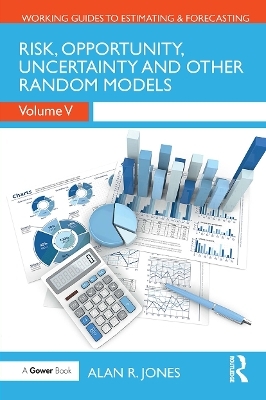
Risk, Opportunity, Uncertainty and Other Random Models
Routledge (Verlag)
978-1-032-83879-3 (ISBN)
Risk, Opportunity, Uncertainty and Other Random Models (Volume V in the Working Guides to Estimating and Forecasting series) goes part way to debunking the myth that research and development cost are somewhat random, as under certain conditions they can be observed to follow a pattern of behaviour referred to as a Norden-Rayleigh Curve, which unfortunately has to be truncated to stop the myth from becoming a reality! However, there is a practical alternative in relation to a particular form of PERT-Beta Curve.
However, the major emphasis of this volume is the use of Monte Carlo Simulation as a general technique for narrowing down potential outcomes of multiple interacting variables or cost drivers. Perhaps the most common of these in the evaluation of Risk, Opportunity and Uncertainty. The trouble is that many Monte Carlo Simulation tools are ‘black boxes’ and too few estimators and forecasters really appreciate what is happening inside the ‘black box’. This volume aims to resolve that and offers tips into things that might need to be considered to remove some of the uninformed random input that often creates a misinformed misconception of ‘it must be right!’
Monte Carlo Simulation can be used to model variable determine Critical Paths in a schedule, and is key to modelling Waiting Times and cues with random arisings. Supported by a wealth of figures and tables, this is a valuable resource for estimators, engineers, accountants, project risk specialists as well as students of cost engineering.
Alan R. Jones is Principal Consultant at Estimata Limited, aconsultancy service specialising in Estimating Skills Training. He is a Certified Cost Estimator/Analyst (US) and Certified Cost Engineer (CCE) (UK). Prior to setting up his own business, he enjoyed a 40-year career in the UK aerospace and defence industry as an estimatorAlan is a Fellow of the Association of Cost Engineers and a member of the International Cost Estimating and Analysis Association. Historically (some four decades ago), Alan was a graduate in Mathematics from Imperial College of Science and Technology in London, and was an MBA Prize-winner at the Henley Management College.
List of Figures
List of Tables
Foreword
Introduction and objectives
Why write this book? Who might find it useful? Why five volumes?
Why write this series? Who might find it useful?
Why five volumes?
Features you’ll find in this book and others in this series
Chapter context
The lighter side (humour)
Quotations
Definitions
Discussions and explanations with a mathematical
slant for Formula-philes
Discussions and explanations without a mathematical
slant for Formula-phobes
Caveat augur
Worked examples
Useful Microsoft Excel functions and facilities
References to authoritative sources
Chapter reviews
Overview of chapters in this volume
Elsewhere in the ‘Working Guide to Estimating & Forecasting’ series
Volume I: Principles, Process and Practice of Professional
Number Juggling
Volume II: Probability, Statistics and Other Frightening Stuff
Volume III: Best Fit Lines and Curves, and
Some Mathe-Magical Transformations
Volume IV: Learning, Unlearning and Re-Learning Curves
Volume V: Risk, Opportunity, Uncertainty and Other
Random Models
Final thoughts and musings on this volume and series
References
Norden-Rayleigh Curves for solution development
Norden-Rayleigh Curves:Who, what, where, when and why?
Probability Density Function and Cumulative Distribution Function
Truncation options
How does a Norden-Rayleigh Curve differ from the
Rayleigh Distribution?
Some practical limitations of the Norden-Rayleigh Curve
Breaking the Norden-Rayleigh ‘Rules’
Additional objectives: Phased development (or the ‘camelling’)
Correcting an overly optimistic view of the problem
complexity:The Square Rule
Schedule slippage due to resource ramp-up delays:
The Pro Rata Product Rule
Schedule slippage due to premature resource reduction
Beta Distribution: A practical alternative to Norden-Rayleigh
PERT-Beta Distribution: A viable alternative to Norden-Rayleigh?
Resource profiles with Norden-Rayleigh Curves
and Beta Distribution PDFs
Triangular Distribution: Another alternative to Norden-Rayleigh
Truncated Weibull Distributions and their Beta equivalents
Truncated Weibull Distributions for solution development
General Beta Distributions for solution development
Estimates to Completion with Norden-Rayleigh Curves
Guess and Iterate Technique
Norden-Rayleigh Curve fitting with Microsoft Excel Solver
Linear transformation and regression
Exploiting Weibull Distribution’s double log linearisation constraint
Estimates to Completion – Review and conclusion
Chapter review
References
Monte Carlo Simulation and other random thoughts
Monte Carlo Simulation:Who, what, why, where,
when and how
Origins of Monte Carlo Simulation: Myth and mirth
Relevance to estimators and planners
Key principle: Input variables with an uncertain future
Common pitfalls to avoid
Is our Monte Carlo output normal?
Monte Carlo Simulation: A model of accurate imprecision
What if we don’t know what the true Input Distribution
Functions are?
Monte Carlo Simulation and correlation
Independent random uncertain events – How real is that?
Modelling semi-independent uncertain events
(bees and hedgehogs)
Chain-Linked Correlation models
Hub-Linked Correlation models
Using a Hub-Linked model to drive a background
isometric correlation
Which way should we go?
A word of warning about negative correlation in Monte Carlo Simulation
Modelling and analysis of Risk, Opportunity and Uncertainty
Sorting the wheat from the chaff
Modelling Risk Opportunity and Uncertainty in a single model
Mitigating Risks, realising Opportunities and contingency planning
Getting our Risks, Opportunities and Uncertainties in a tangle
Dealing with High Probability Risks
Beware of False Prophets: Dealing with Low Probability
High Impact Risks
Using Risk or Opportunity to model extreme values
of Uncertainty
Modelling Probabilities of Occurrence
Other random techniques for evaluating Risk, Opportunity and Uncertainty
ROU Analysis: Choosing appropriate values with confidence
Monte Carlo Risk and Opportunity Analysis is
fundamentally flawed!
Chapter review
References
Risk, Opportunity and Uncertainty: A holistic perspective
Top-down Approach to Risk, Opportunity and Uncertainty
Top-down metrics
Marching Army Technique: Cost-schedule related variability
Assumption Uplift Factors: Cost variability independent
of schedule variability
Lateral Shift Factors: Schedule variability independent
of cost variability
An integrated Top-down Approach
Bridging into the unknown: Slipping and
Sliding Technique
Using an Estimate Maturity Assessment as a guide to ROU maturity
Chapter review
References
Factored Value Technique for Risks and Opportunities
The wrong way
A slightly better way
The best way
Chapter review
Reference
Introduction to Critical Path and Schedule Risk Analysis
What is Critical Path Analysis?
Finding a Critical Path using Binary Activity Paths in Microsoft Excel
Using Binary Paths to find the latest start and finish times, and float
Using a Critical Path to Manage Cost and Schedule
Modelling variable Critical Paths using Monte Carlo Simulation
Chapter review
References
Finally, after a long wait … Queueing Theory
Types of queues and service discipline
Memoryless queues
Simple single channel queues (M/M/1 and M/G/1)
Example of Queueing Theory in action M/M/1 or M/G/1
Multiple channel queues (M/M/c)
Example of Queueing Theory in action M/M/c or M/G/c
How do we spot a Poisson Process?
When is Weibull viable?
Can we have a Poisson Process with an increasing/decreasing trend?
Chapter review
References
Epilogue
Glossary of estimating and forecasting terms
Legend for Microsoft Excel Worked Example Tables in Greyscale
Index
| Erscheinungsdatum | 23.08.2024 |
|---|---|
| Reihe/Serie | Working Guides to Estimating & Forecasting |
| Verlagsort | London |
| Sprache | englisch |
| Maße | 156 x 234 mm |
| Gewicht | 580 g |
| Themenwelt | Kunst / Musik / Theater ► Design / Innenarchitektur / Mode |
| Wirtschaft ► Volkswirtschaftslehre | |
| ISBN-10 | 1-032-83879-5 / 1032838795 |
| ISBN-13 | 978-1-032-83879-3 / 9781032838793 |
| Zustand | Neuware |
| Haben Sie eine Frage zum Produkt? |
aus dem Bereich


